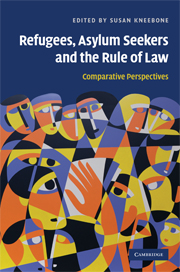Book contents
- Frontmatter
- Contents
- Contributors
- Foreword
- Preface
- Introduction: Refugees and Asylum Seekers in the International Context – Rights and Realities
- 1 The Rule of Law and the Role of Law: Refugees and Asylum Seekers
- 2 Asylum and the Rule of Law in Canada: Hearing the Other (Side)
- 3 Refugees, Asylum and the Rule of Law in the USA
- 4 The Australian Story: Asylum Seekers outside the Law
- 5 The Intersection between the International, the Regional and the Domestic: Seeking Asylum in the UK
- 6 Conclusions on the Rule of Law
- Appendix
- Bibliography
- Index
2 - Asylum and the Rule of Law in Canada: Hearing the Other (Side)
Published online by Cambridge University Press: 10 December 2009
- Frontmatter
- Contents
- Contributors
- Foreword
- Preface
- Introduction: Refugees and Asylum Seekers in the International Context – Rights and Realities
- 1 The Rule of Law and the Role of Law: Refugees and Asylum Seekers
- 2 Asylum and the Rule of Law in Canada: Hearing the Other (Side)
- 3 Refugees, Asylum and the Rule of Law in the USA
- 4 The Australian Story: Asylum Seekers outside the Law
- 5 The Intersection between the International, the Regional and the Domestic: Seeking Asylum in the UK
- 6 Conclusions on the Rule of Law
- Appendix
- Bibliography
- Index
Summary
The first part of this chapter provides an historical overview of the Canadian asylum process. The second part explores how international and constitutional law structures shapes and constrains asylum law in Canada. The next two sections discuss elements of the asylum regime through an enlarged conception of the right to be heard. In its traditional and limited iteration (audi alteram partem, or ‘hear the other side’), this right is familiar to any student of administrative law in the common law world. A somewhat figurative concept of the right to be heard is used here in order to consider different points in Canadian legal and geographical space where the asylum seeker's audibility is enabled or muted. In particular, attention is drawn to the limits imposed by conventional legal doctrine on what will be, or can be, heard from the other side of a cultural divide, a hearing room, or a border. The conclusion contemplates a separate but related dialogue that has emerged recently, partly in response to the obfuscating noise and troubling silences in the existing regime.
Part one: the asylum seeker in the Canadian legal system
Canada is a settler society par excellence. Almost 20 per cent of the population is foreign-born, putting it right behind Australia as a country of immigration in empirical terms. Canada is also a country of immigration in the normative sense; official discourse celebrates immigration as constitutive of the nation.
- Type
- Chapter
- Information
- Refugees, Asylum Seekers and the Rule of LawComparative Perspectives, pp. 78 - 121Publisher: Cambridge University PressPrint publication year: 2009
- 5
- Cited by

